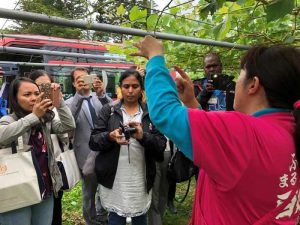
Select Page
 Good Agricultural Practices (GAP) are meant to ensure food safety, environmental conservation, and fair labor practices throughout food value chains. GAP certification continues to increase in importance, as it can be a deciding factor in consumers’ choices of agricultural products, more importers require exporters to be certified, and numerous international events only allow GAP-certified food procurement. Under a special cash grant from the Japanese Ministry of Agriculture, Forestry and Fisheries, 18 senior agricultural policymakers and planners, officers of agribusiness associations, and academics from 11 APO member countries had the opportunity to attend an observational study mission (OSM) on Good Agricultural Practices and Advanced Postharvest Handling Techniques in Japan, 10–14 June 2019.
Good Agricultural Practices (GAP) are meant to ensure food safety, environmental conservation, and fair labor practices throughout food value chains. GAP certification continues to increase in importance, as it can be a deciding factor in consumers’ choices of agricultural products, more importers require exporters to be certified, and numerous international events only allow GAP-certified food procurement. Under a special cash grant from the Japanese Ministry of Agriculture, Forestry and Fisheries, 18 senior agricultural policymakers and planners, officers of agribusiness associations, and academics from 11 APO member countries had the opportunity to attend an observational study mission (OSM) on Good Agricultural Practices and Advanced Postharvest Handling Techniques in Japan, 10–14 June 2019.
The seven resource persons for the OSM included representatives of the Japan GAP Foundation, GAP Research Institute, Japan Agricultural Cooperative of Miyagi-Tome, Fukushima Prefectural Government, and GAP-certified farming operations. Their presentations covered: how GAP improves farm management, makes producers more competitive, and benefits consumers through safer food; different GAP versions prevalent in various regions; advances in postharvest technology to increase productivity, and maintain freshness; and the food procurement policy of the 2020 Tokyo Olympic/Paralympic Games, which requires GAP certification.
The mission included five site visits to farms showcasing how GAP certification contributes to their operations, how sensor technology and other smart farming applications helped to develop a new, sweeter tomato variety, and how initial challenges in adhering to the standard were overcome. The resource persons assisted in the preparation of action plans by participants, which incorporated learning points from the visits and presentations, to promote GAP certification and improve the postharvest handling of fresh fruit and vegetables in their own agricultural settings.